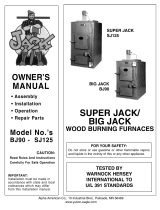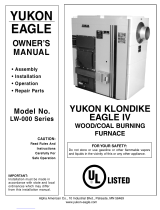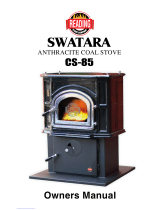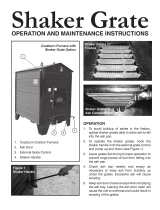Page is loading ...

12/2015
Installation must be made in accordance with local and state codes which
may dier from manual. Save these instructions.
Phone 715/654-5132
Fax 715/654-5513
INSRUCTION AND PARTS BOOK
FOR
MODELS 526, 2900, & 4000
WOOD / COAL FURNACES
The Undefeated Heavyweight Champion!
Manufactured by
Meyer Mfg. Corp
Dorchester, Wisconsin 54425

2
TRANSPORTATION DAMAGES
Before reading this manual and proceeding with the installation, inspect your new Woodchuck to make sure there
were no shipping damages. If you find there have been damages incurred, call your dealer immediately. He will
then take a course of action to correct the problem.
We are constantly improving and updating our product in order to provide the
highest quality and value possible. Consequently pictures might sometimes differ
slightly from the actual product.
INTRODUCTION
Dear Woodchuck Owner,
Congratulations on your purchase of a Woodchuck heating appliance. Un-
doubtedly you have given much consideration to your purchase and we’re
proud that you have selected a Woodchuck. Pride in craftsmanship and engi-
neering have made your Woodchuck the finest heating appliance available to-
day.
Solid fuels are abundant and inexpensive. Wood is our only renewable
source of fuel and conservative estimates put our coal reserves at 800 years.
Our dual fuel units provide the savings and comfort of solid fuels and the con-
venience of electric heat in one attractive package.
There is no substitute for quality. That is why thousands of people like you
have purchased a Woodchuck. They also felt it was the best equipment to
serve their heating needs, now and in years to come. We ask that you follow
our policy of “safety first” and we strongly suggest that you read through the
owner’s manual before installing and operating your furnace.
For a lifetime of satisfaction, thank you for not compromising quality.
Sincerely,
Donald A. Meyer
President
MEYER MANUFACTURING CORP.

3
Introduction .....................................................2
Furnace Safety ...................................................4
Specifications ....................................................5
General Information .................................................6
High Quality Construction ...........................................6
Efficiency ....................................................6
Comfort .....................................................6
Additional Comfort and Saving .........................................7
Operation ......................................................8
Common Sense.................................................8
! If You Have a Chimney Fire ! .........................................8
! Important ! Operation Procedure in the Event of Power Failure .......................8
Operating Your Woodchuck Furnace ......................................9
Startup .....................................................9
Electrical Switches ...............................................9
Burning Wood in Your Woodchuck .......................................10
Helpful Hints ..................................................10
Ash Removal .................................................10
Burning Coal in Your Woodchuck........................................11
Starting a Coal Fire ..............................................11
Recharging ..................................................11
Banking ....................................................11
Bituminous Recharging ............................................11
Helpful Hints ..................................................12
Ash Removal .................................................12
Maintenance ....................................................13
Trouble Shooting .................................................14
General Requirements .............................................16
Placement and Minimum Clearances......................................16
Installation .....................................................16
Chimney Installation...............................................18
Installing Your Woodchuck ...........................................19
Stove Pipe Installation .............................................19
Installation of a Barometric Draft ........................................19
Air Duct Installation ...............................................20
Woodchuck Final Assembly...........................................21
Optional Shaker Grate Installation for Model 526...............................21
Install Shaker Grate Handle, Model 2900 Only ................................22
Install Firebrick ................................................23
Install Optional Catalytic Combustor (Model 2900/4000) ...........................24
Assemble Manual Draft-Model 526 Only ...................................24
Install Comfort Control Center and Forced Draft Blower ...........................24
Install Circulating Blower ...........................................25
Install Filter Box ................................................25
Electrical Hookup ...............................................26
Repair Parts ....................................................28
Personal Data Information for Future Reference ................................34
How to Read Your Serial Number .......................................34
Limited Warranty ................................................35
TABLE OF CONTENTS

FURNACE SAFETY
DANGER:
DANGER:
DANGER:
CAUTION:
WARNING:
CAUTION:

Air Filter 1 x 16 x 20
Air Filter 1 x 16 x 20 Air Filter 1 x 16 x 20
SPECIFICATIONS

GENERAL INFORMATION

OPERATION
DANGER:
DANGER:
CAUTION:

CAUTION
CAUTION
BURNING COAL IN YOUR
WOODCHUCK
CAUTION:

CAUTION

13
WARNING:
DISCONNECT APPLIANCE FROM ELECTRICAL
SUPPLY BEFORE SERVICING UNIT. FAILURE TO
HEED MAY RESULT IN SERIOUS PERSONAL INJURY
OR DEATH.
Keep chimney and smoke pipe clean by cleaning at least
twice during a heating season. Keeping your chimney
and stove pipes clean is the best insurance against
chimney res.
If you clean your own chimney and stovepipe, Meyer
Manufacturing Corp. recommends purchasing the same
equipment professionals use. Brushes are available in
enough sizes and shapes to snuggly t inside any com-
mon ue.
Replace any cracked or deteriorated rebrick. This will
prolong the life expectancy of the rebox.
Check door gasket and replace as needed.
Keep ash pit clean especially when burning coal.
Check 1 x 16 x 20 air lter (not provided) monthly and
replace as needed. Change lter at least twice per year.
Turn on your regular furnace once every month to keep
it tuned up and limber.
OPTIONAL CATALYTIC COMBUSTOR
FOR MODELS 2900/4000
Optional catalyst not recommended for Model
2900/4000 with 6" ue adapter. Smoke spillage may oc -
cur out of door when refueling.
Even with complete combustion there is a small amount
of residue. Eventually enough will collect on the
combustor to interfere with its operation. Therefore it is
necessary to clean it periodically. To clean the
combustor simply remove from unit and run tap water
through it until no sign of residue remains. The
combustor simply slides up into the exhaust pipe stub
which protrudes down into the rebox. There are three
rods on the combustor which engage slots in the pipe
and then turn slightly to lock in place. These rods are not
symmetrical so observe their orientation when you re -
move it. Two rods are welded at 90° and they point to-
ward the rear of the rebox.
CATALYTIC ELEMENT
RODS ON RETAINER
NOTCHES IN EXHAUST
PIPE
OPTIONAL CATALYTIC
COMBUSTOR
MAINTENANCE
NOTE:

TROUBLE SHOOTING


19
When using approved factory built metal chimneys, you
must have at least 2" of clearance when going through
a wall or next to a wall. A typical factory chimney instal-
lation is shown on figure 9.
INSTALLING YOUR WOODCHUCK
Most of the Woodchuck furnace is factory assembled.
The factory assembly should be located as detailed in
the PLACEMENT AND MINIMUM CLEARANCES sec-
tion and on figure 7.
Remaining assembly will consist of mounting the con-
trols, draft and circulating blowers, filter box if used, and
electrical connection. These details will be provided af-
ter stove pipe and air duct installation.
STOVE PIPE INSTALLATION
Install your Wood/Coal unit as close to the chimney as
possible with a minimum of elbows. We recommend no
more than two elbows. The maximum horizontal run
should not exceed 6 feet with a 1/2" rise per foot. The
pipe should maintain a minimum of a 1/2" rise per foot
and NEVER be installed closer than 18" from combusti-
bles. Exceeding these recommendations normally rep-
resents creosote build-up, a smoking furnace, or one
with poor draft.
When connecting stove pipe, all joints should be se-
cured with at least three #10 sheet metal screws.
NOTE: If it is absolutely necessary to make a run
greater than 6 feet (not recommended), use extra sup-
port brackets every 3 ft.
The connection to the wood furnace’s collar must also
be more than just a snug fit. Drill holes through the
Woodchuck’s collar and secure with sheet metal
screws. Mark each connection for cleaning. This will
prevent frustration when matching up your hole pattern
again.
DAMPERS IN STOVE PIPES
A manual damper may be installed at a safe convenient
place between the barometric damper and the chimney.
In the event of chimney fire, it can quickly be closed
reducing draft to the chimney. See figure 10.
INSTALLATION OF A BAROMETRIC
DRAFT
Some codes and NFPA require draft regulators in the
chimney connector of wood or coal furnaces and boil-
ers, and manufacturers recommend their use with some
stoves. There is some doubt among wood heat experts
as to whether use of barometric draft regulators is wise.
Draft regulators limit the draft-the suction pulling air into
the appliance. A pivoted, counter-balanced flap is
pulled open by the draft when the draft reaches a criti-
cal amount (figure 10). This permits air to enter the
chimney, thus preventing the draft in the appliance from
rising any higher.
Use of draft regulators with oil-fired equipment is com-
mon. One objective is to keep the oil flame from being
blown out by excessive draft. This is more an annoy-
ance than a safety problem since most oil burners have
primary safety controls which stop the fuel flow into the
burner whenever the flame goes out, and modern
flame-retention burner design makes draft regulation al-
most unnecessary for this objective.
A second objective is to limit the amount of air passing
through the system in order to maintain high heat trans-
fer efficiency. Another desirable consequence is a de-
crease in peak chimney temperatures due to the added
air entering through the regulator.
High draft does not blow out the flames but fans them in
wood and coal burning equipment. An especially hot
fire can result. Control of the fire may be difficult, partic-
ularly if the wood burner is not airtight. Energy efficien-
cies may be adversely affected, and chimney fires may
be ignited. A barometric draft regulator can alleviate
these problems by limiting the flow of combustion air
into the appliance and by adding cooling air to the hot
flue gases.
However the cooling air may result in more creosote
accumulation, and if a chimney fire does start, it will be
more intense because of the draft regulator. Large
flows of air into the regulator will fan the fire in the
chimney. Thus the net effect of barometric draft
regulators is unclear-they help in some aspects, and
hurt in others. Note, though, that if a chimney is clean
so that chimney fires are impossible, a draft regulator
does no harm, and does help limit the intensity of the
fire in the appliance, and it helps prevent the flue gases
in the chimney from getting too hot. Barometric draft
regulators are recommended by JFPA for hand fired
thermostatically controlled solid fuel furnaces.
SUGGESTED TYPE
DAMPER
AIR HOLES
/














